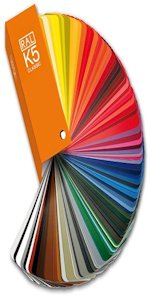
|
RAL Color Space System Standards
RAL Classic:
In 1927 the German Reichs-Ausschuß für Lieferbedingungen und
Gütesicherung"
(Imperial Commission for Delivery Terms and Quality Assurance) invented a
collection of 40 colors under the name of "RAL 840." Prior to that date
manufacturers and customers had to exchange samples to describe a tint, whereas
from then on they would rely on numbers.
In the 1930s the numbers were changed uniformly to four digits and the
collection was renamed to "RAL 840 R" (R for revised). With tints constantly
added to the collection, it was revised again in 1961 and changed to "RAL
840-HR", which consists of 210 colors and is in use to this day. In the 1960s
the colors were given supplemental names to avoid confusion in case of
transposed digits.
As "RAL 840-HR" covered only matte paint the 1980s saw the invention of "RAL
841-GL" for glossy surfaces, limited to 193 colors. A main criterion for colors
in the RAL Classic collection is to be of "paramount interest". Therefore most
of the colors in it are used on warning and traffic signs or are dedicated to
government agencies and public services (for example: RAL 1004 - Swiss Postal
Service, RAL 1021 - Austrian Postal Service, RAL 1032 - German Postal
Service).
RAL Design:
In 1993 a new color matching system was introduced, tailored to the needs of
architects, designers and advertisers. It started with 1688 colors and was
revised to 1625 colors. Contrary to the preceding systems RAL Design features
no names and its numbering follows a scheme based on the CIELAB color space.
Each color is represented by 7 digits, grouped in a triple and 2 pairs,
representing hue, brightness and saturation. The colors of RAL Classic and RAL
Design do not intersect.
"Colour Feeling 09/10" is primarily designed as a professional planning tool
for designers, architects, interior designers, interior decorators and
painters. It is meant to be a source of inspiration on how to creatively
combine the main trend colors for the coming two years. But also general
consumers can be inspired by the work book to develop their own ideas and to
create their personal color design.
Return
|
